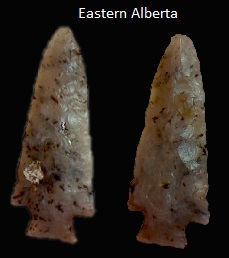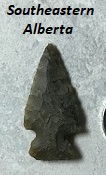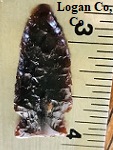Name Details:
Named By: Thomas F. Kehoe
Named For:
Date Identified: 1974
Type Site:
Samantha
Also see Samantha Dart
Cluster: Plains Large Corner Notch Cluster
Commonly Utilized Material:
Date:
Cultural Period:
1,700 -1,200 B.P.
Transitional Archaic to Developmental
Roman Warm to Vandal
Minimum /
Scandic Period
Besant Culture
Glacial Period:
Culture:
Outline is Representative of Size and Shape:
Description of Physical Characteristics and Flaking Pattern:
This is a
small to medium triangular corner to side notch point with a flattened cross section. The blade may range from excurvate to straight. Shoulders are commonly slightly barbed to horizontal. Some examples may have upward sloping shoulders. The
distance between the tip and the shoulders should be about the same distance as the width of the shoulders on the dart points. The stem is expanding with a
slightly convex to slightly concave base. This point has a random flaking pattern.
Size Measurements: Total Length - 23 to 50 mm
(average 30 to 40 mm), Stem Length -5 to 8 mm, Blade
Width - 7 to 17 mm, Neck Width - 7 to 11 mm, Stem Width
- 11 to 26 mm
Distribution:
Distribution Comments:
These points are primarily found in the Northern Plains in areas associated with the Besant Culture. It is most commonly found from Alberta and Saskatchewan and into Montana, North Dakota, and Minnesota. They may be found into northern Colorado and northern Nebraska.

Related / Associated Points:
Additional Comments:
The oldest point s this cluster are the Pelican lake points from the Pelican Lake culture. These points overlap with the
Besant points are the oldest of the Besant culture. Samantha points
followed (and may have continued for a period of time) the Besant point. (W2).
The Pelican Lake point is thought to have been influenced by the Hopewell culture. Pelican Lake points overlap with the use of the Besant point (W2).
These points started as dart points along with the Besant point and were transformed into arrow points.
Morrow (2016) notes the overlapping characteristics and dates of the
Samantha and Besant types. He suggest that the Samantha type may
be a variant of the Besant point.
This type has been divided into the dart form and the arrow form. The dart form is slightly larger than the arrow form.
The difference between the dart form and the arrow form can be small.
Hildebrandt and King (2012) proposed a formula for determining the
difference between a dart and arrow.
Neck Width + Maximum Thickness = Dart-Arrow Index
If Dart - Arrow index is greater than 11.8 mm = dart
If Dart- Arrow index is less than 11.8 mm = arrow
Point Validity: Valid Type
Kehoe is a
distinguished
Anthropologist who worked extensively on archeology of Montana and served as both a professor and curator at the Museum of the Plains Indian at Browning Montana. This type
was named in a professional publication and has many professional references. This is considered a valid type.
.
Age Details:
References: (See Reference Page, Entry Number):
30, 168, W2, W4, W8
Samantha Projectile Point, Samantha Arrowhead



